Zhengying Liu
TAU, LISN
FormalAlign: Automated Alignment Evaluation for Autoformalization
Oct 14, 2024Abstract:Autoformalization aims to convert informal mathematical proofs into machine-verifiable formats, bridging the gap between natural and formal languages. However, ensuring semantic alignment between the informal and formalized statements remains challenging. Existing approaches heavily rely on manual verification, hindering scalability. To address this, we introduce \textsc{FormalAlign}, the first automated framework designed for evaluating the alignment between natural and formal languages in autoformalization. \textsc{FormalAlign} trains on both the autoformalization sequence generation task and the representational alignment between input and output, employing a dual loss that combines a pair of mutually enhancing autoformalization and alignment tasks. Evaluated across four benchmarks augmented by our proposed misalignment strategies, \textsc{FormalAlign} demonstrates superior performance. In our experiments, \textsc{FormalAlign} outperforms GPT-4, achieving an Alignment-Selection Score 11.58\% higher on \forml-Basic (99.21\% vs. 88.91\%) and 3.19\% higher on MiniF2F-Valid (66.39\% vs. 64.34\%). This effective alignment evaluation significantly reduces the need for manual verification. Both the dataset and code can be accessed via~\url{https://github.com/rookie-joe/FormalAlign}.
ToolACE: Winning the Points of LLM Function Calling
Sep 02, 2024



Abstract:Function calling significantly extends the application boundary of large language models, where high-quality and diverse training data is critical for unlocking this capability. However, real function-calling data is quite challenging to collect and annotate, while synthetic data generated by existing pipelines tends to lack coverage and accuracy. In this paper, we present ToolACE, an automatic agentic pipeline designed to generate accurate, complex, and diverse tool-learning data. ToolACE leverages a novel self-evolution synthesis process to curate a comprehensive API pool of 26,507 diverse APIs. Dialogs are further generated through the interplay among multiple agents, guided by a formalized thinking process. To ensure data accuracy, we implement a dual-layer verification system combining rule-based and model-based checks. We demonstrate that models trained on our synthesized data, even with only 8B parameters, achieve state-of-the-art performance on the Berkeley Function-Calling Leaderboard, rivaling the latest GPT-4 models. Our model and a subset of the data are publicly available at https://huggingface.co/Team-ACE.
FVEL: Interactive Formal Verification Environment with Large Language Models via Theorem Proving
Jun 20, 2024


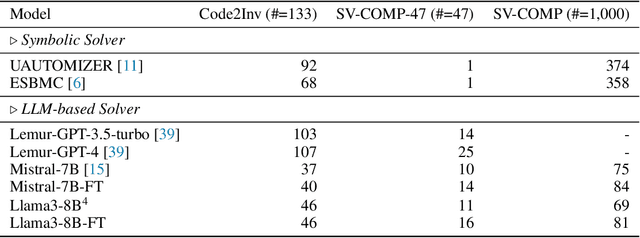
Abstract:Formal verification (FV) has witnessed growing significance with current emerging program synthesis by the evolving large language models (LLMs). However, current formal verification mainly resorts to symbolic verifiers or hand-craft rules, resulting in limitations for extensive and flexible verification. On the other hand, formal languages for automated theorem proving, such as Isabelle, as another line of rigorous verification, are maintained with comprehensive rules and theorems. In this paper, we propose FVEL, an interactive Formal Verification Environment with LLMs. Specifically, FVEL transforms a given code to be verified into Isabelle, and then conducts verification via neural automated theorem proving with an LLM. The joined paradigm leverages the rigorous yet abundant formulated and organized rules in Isabelle and is also convenient for introducing and adjusting cutting-edge LLMs. To achieve this goal, we extract a large-scale FVELER3. The FVELER dataset includes code dependencies and verification processes that are formulated in Isabelle, containing 758 theories, 29,125 lemmas, and 200,646 proof steps in total with in-depth dependencies. We benchmark FVELER in the FVEL environment by first fine-tuning LLMs with FVELER and then evaluating them on Code2Inv and SV-COMP. The results show that FVEL with FVELER fine-tuned Llama3- 8B solves 17.39% (69 -> 81) more problems, and Mistral-7B 12% (75 -> 84) more problems in SV-COMP. And the proportion of proof errors is reduced. Project page: https://fveler.github.io/.
Process-Driven Autoformalization in Lean 4
Jun 04, 2024



Abstract:Autoformalization, the conversion of natural language mathematics into formal languages, offers significant potential for advancing mathematical reasoning. However, existing efforts are limited to formal languages with substantial online corpora and struggle to keep pace with rapidly evolving languages like Lean 4. To bridge this gap, we propose a new benchmark \textbf{Form}alization for \textbf{L}ean~\textbf{4} (\textbf{\name}) designed to evaluate the autoformalization capabilities of large language models (LLMs). This benchmark encompasses a comprehensive assessment of questions, answers, formal statements, and proofs. Additionally, we introduce a \textbf{P}rocess-\textbf{S}upervised \textbf{V}erifier (\textbf{PSV}) model that leverages the precise feedback from Lean 4 compilers to enhance autoformalization. Our experiments demonstrate that the PSV method improves autoformalization, enabling higher accuracy using less filtered training data. Furthermore, when fine-tuned with data containing detailed process information, PSV can leverage the data more effectively, leading to more significant improvements in autoformalization for Lean 4. Our dataset and code are available at \url{https://github.com/rookie-joe/PDA}.
Proving Theorems Recursively
May 23, 2024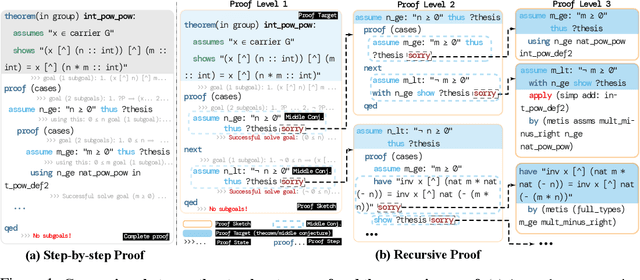

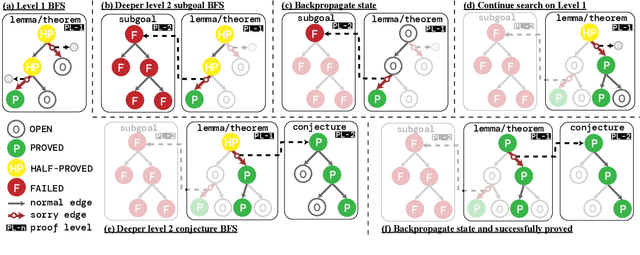
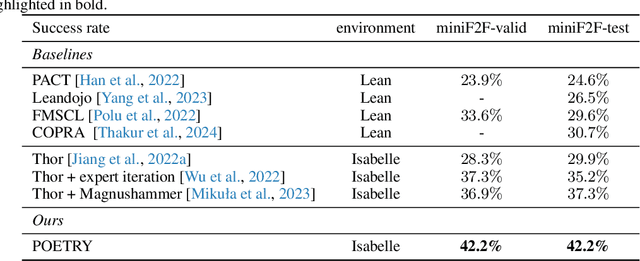
Abstract:Recent advances in automated theorem proving leverages language models to explore expanded search spaces by step-by-step proof generation. However, such approaches are usually based on short-sighted heuristics (e.g., log probability or value function scores) that potentially lead to suboptimal or even distracting subgoals, preventing us from finding longer proofs. To address this challenge, we propose POETRY (PrOvE Theorems RecursivelY), which proves theorems in a recursive, level-by-level manner in the Isabelle theorem prover. Unlike previous step-by-step methods, POETRY searches for a verifiable sketch of the proof at each level and focuses on solving the current level's theorem or conjecture. Detailed proofs of intermediate conjectures within the sketch are temporarily replaced by a placeholder tactic called sorry, deferring their proofs to subsequent levels. This approach allows the theorem to be tackled incrementally by outlining the overall theorem at the first level and then solving the intermediate conjectures at deeper levels. Experiments are conducted on the miniF2F and PISA datasets and significant performance gains are observed in our POETRY approach over state-of-the-art methods. POETRY on miniF2F achieves an average proving success rate improvement of 5.1%. Moreover, we observe a substantial increase in the maximum proof length found by POETRY, from 10 to 26.
ATG: Benchmarking Automated Theorem Generation for Generative Language Models
May 05, 2024Abstract:Humans can develop new theorems to explore broader and more complex mathematical results. While current generative language models (LMs) have achieved significant improvement in automatically proving theorems, their ability to generate new or reusable theorems is still under-explored. Without the new theorems, current LMs struggle to prove harder theorems that are distant from the given hypotheses with the exponentially growing search space. Therefore, this paper proposes an Automated Theorem Generation (ATG) benchmark that evaluates whether an agent can automatically generate valuable (and possibly brand new) theorems that are applicable for downstream theorem proving as reusable knowledge. Specifically, we construct the ATG benchmark by splitting the Metamath library into three sets: axioms, library, and problem based on their proving depth. We conduct extensive experiments to investigate whether current LMs can generate theorems in the library and benefit the problem theorems proving. The results demonstrate that high-quality ATG data facilitates models' performances on downstream ATP. However, there is still room for current LMs to develop better ATG and generate more advanced and human-like theorems. We hope the new ATG challenge can shed some light on advanced complex theorem proving.
MUSTARD: Mastering Uniform Synthesis of Theorem and Proof Data
Feb 14, 2024Abstract:Recent large language models (LLMs) have witnessed significant advancement in various tasks, including mathematical reasoning and theorem proving. As these two tasks require strict and formal multi-step inference, they are appealing domains for exploring the reasoning ability of LLMs but still face important challenges. Previous studies such as Chain-of-Thought (CoT) have revealed the effectiveness of intermediate steps guidance. However, such step-wise annotation requires heavy labor, leading to insufficient training steps for current benchmarks. To fill this gap, this work introduces MUSTARD, a data generation framework that masters uniform synthesis of theorem and proof data of high quality and diversity. MUSTARD synthesizes data in three stages: (1) It samples a few mathematical concept seeds as the problem category. (2) Then, it prompts a generative language model with the sampled concepts to obtain both the problems and their step-wise formal solutions. (3) Lastly, the framework utilizes a proof assistant (e.g., Lean Prover) to filter the valid proofs. With the proposed MUSTARD, we present a theorem-and-proof benchmark MUSTARDSAUCE with 5,866 valid data points. Each data point contains an informal statement, an informal proof, and a translated formal proof that passes the prover validation. We perform extensive analysis and demonstrate that MUSTARD generates validated high-quality step-by-step data. We further apply the MUSTARDSAUCE for fine-tuning smaller language models. The fine-tuned Llama 2-7B achieves a 15.41% average relative performance gain in automated theorem proving, and 8.18% in math word problems. Codes and data are available at https://github.com/Eleanor-H/MUSTARD.
A Survey of Reasoning with Foundation Models
Dec 26, 2023

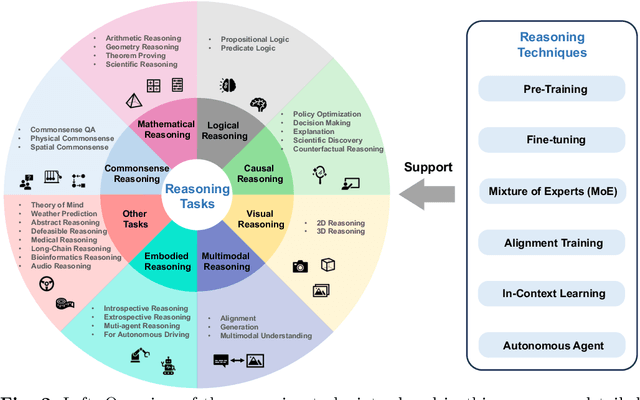
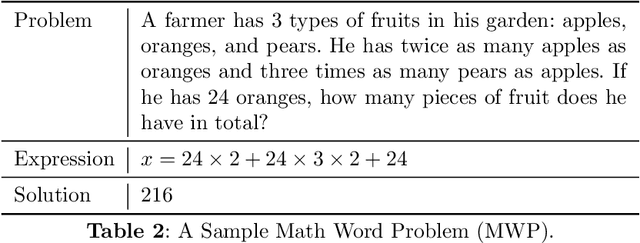
Abstract:Reasoning, a crucial ability for complex problem-solving, plays a pivotal role in various real-world settings such as negotiation, medical diagnosis, and criminal investigation. It serves as a fundamental methodology in the field of Artificial General Intelligence (AGI). With the ongoing development of foundation models, there is a growing interest in exploring their abilities in reasoning tasks. In this paper, we introduce seminal foundation models proposed or adaptable for reasoning, highlighting the latest advancements in various reasoning tasks, methods, and benchmarks. We then delve into the potential future directions behind the emergence of reasoning abilities within foundation models. We also discuss the relevance of multimodal learning, autonomous agents, and super alignment in the context of reasoning. By discussing these future research directions, we hope to inspire researchers in their exploration of this field, stimulate further advancements in reasoning with foundation models, and contribute to the development of AGI.
Large Language Models as Automated Aligners for benchmarking Vision-Language Models
Nov 24, 2023



Abstract:With the advancements in Large Language Models (LLMs), Vision-Language Models (VLMs) have reached a new level of sophistication, showing notable competence in executing intricate cognition and reasoning tasks. However, existing evaluation benchmarks, primarily relying on rigid, hand-crafted datasets to measure task-specific performance, face significant limitations in assessing the alignment of these increasingly anthropomorphic models with human intelligence. In this work, we address the limitations via Auto-Bench, which delves into exploring LLMs as proficient aligners, measuring the alignment between VLMs and human intelligence and value through automatic data curation and assessment. Specifically, for data curation, Auto-Bench utilizes LLMs (e.g., GPT-4) to automatically generate a vast set of question-answer-reasoning triplets via prompting on visual symbolic representations (e.g., captions, object locations, instance relationships, and etc.). The curated data closely matches human intent, owing to the extensive world knowledge embedded in LLMs. Through this pipeline, a total of 28.5K human-verified and 3,504K unfiltered question-answer-reasoning triplets have been curated, covering 4 primary abilities and 16 sub-abilities. We subsequently engage LLMs like GPT-3.5 to serve as judges, implementing the quantitative and qualitative automated assessments to facilitate a comprehensive evaluation of VLMs. Our validation results reveal that LLMs are proficient in both evaluation data curation and model assessment, achieving an average agreement rate of 85%. We envision Auto-Bench as a flexible, scalable, and comprehensive benchmark for evaluating the evolving sophisticated VLMs.
TRIGO: Benchmarking Formal Mathematical Proof Reduction for Generative Language Models
Oct 24, 2023Abstract:Automated theorem proving (ATP) has become an appealing domain for exploring the reasoning ability of the recent successful generative language models. However, current ATP benchmarks mainly focus on symbolic inference, but rarely involve the understanding of complex number combination reasoning. In this work, we propose TRIGO, an ATP benchmark that not only requires a model to reduce a trigonometric expression with step-by-step proofs but also evaluates a generative LM's reasoning ability on formulas and its capability to manipulate, group, and factor number terms. We gather trigonometric expressions and their reduced forms from the web, annotate the simplification process manually, and translate it into the Lean formal language system. We then automatically generate additional examples from the annotated samples to expand the dataset. Furthermore, we develop an automatic generator based on Lean-Gym to create dataset splits of varying difficulties and distributions in order to thoroughly analyze the model's generalization ability. Our extensive experiments show our proposed TRIGO poses a new challenge for advanced generative LM's including GPT-4 which is pre-trained on a considerable amount of open-source formal theorem-proving language data, and provide a new tool to study the generative LM's ability on both formal and mathematical reasoning.
 Add to Chrome
Add to Chrome Add to Firefox
Add to Firefox Add to Edge
Add to Edge